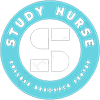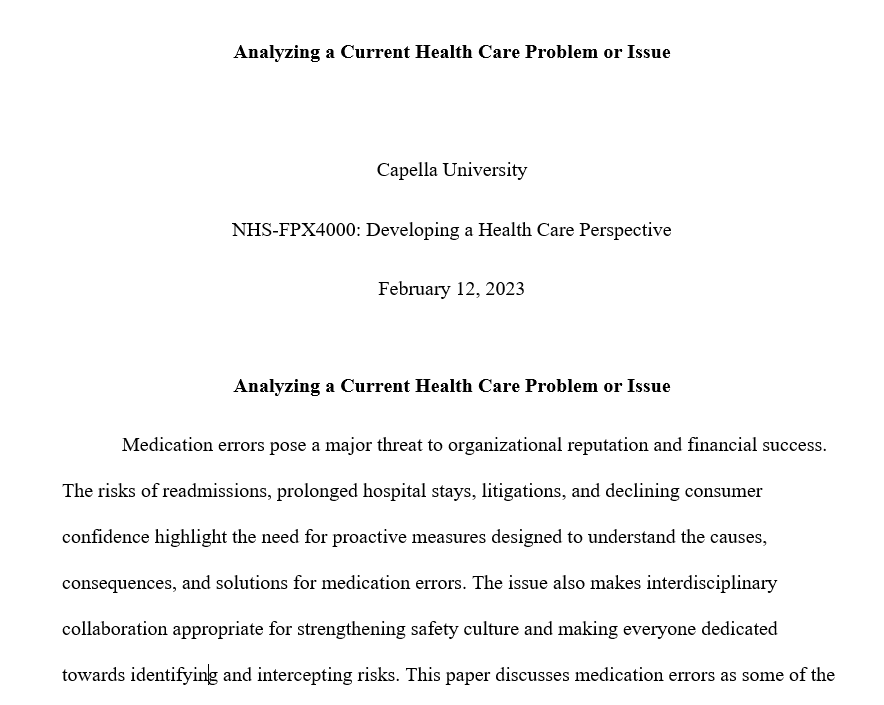Student’s Name
Capella University
NHS-FPX4000: Developing a Health Care Perspective
Professor.
October 31, 2023
Analyzing a Current Health Care Problem
Medication errors are among the problems that jeopardize patient satisfaction and expose an organization to declining revenues. For instance, nurses are vulnerable to administering the wrong drug due to distractions, burnout, poor communication, and other factors within the clinical environment. This paper focuses on medication administration errors as one of the primary concerns for organizations and healthcare professionals seeking to make an impact in a complex healthcare sector.
Medication Administration Error: Wrong Drug Administration
Wrong drug administration is among the primary challenges for patients, healthcare professionals, and organizations. The errors cause adverse drug reactions associated with severe complications, deaths, and additional costs for a hospital, patients, and families. Readmissions and prolonged hospitalization are other undesirable outcomes associated with wrong drug administration (Al Khreem & Al-khadher, 2021). High-risk drugs expose patients to serious consequences, hence the need for increased vigilance, accountability, and responsibility when handling patients with complex medication requirements.
Manias et al. (2020) reminded healthcare professionals to acknowledge the preventable nature of medication errors and help their organizations identify and intercept risks across the continuum. The authors indicate that complete adherence to the rights of medications including, timing, dosage, route, drug, and patient enables nurses and physicians to enhance the quality and safety of patient care. Awareness about the procedures, standards, and practices for administering medications safely makes it easier for the care team to handle patients with serious conditions, including the elderly with multiple challenges and in need of high-risk drugs.
Analysis of the Issue
The issue in this assessment is wrong drug administration triggered by administrative, human, and technical weaknesses. A nurse may administer a fatal dose of the wrong medication, despite the existence of clear warnings before administering the drug. Investigations could reveal other serious mistakes such as distractions by a personal conversation while drawing the drug from a cabinet, failure to check with the hospital’s pharmacy, and ignoring warnings and pop-ups about the selected medication (Kelman & Tamburin, 2019). Additionally, a nurse may administer drugs in powder instead of the recommended liquid form. A scenario revealing the wrong drug administration showed that a nurse injected a drug despite a clear warning on the bottle cap indicating that the chosen medication was a paralyzing agent. Thus, a nurse is likely to face charges of reckless homicide by making mistakes that cause a patient’s death. Nurses should remain vigilant and adhere to medication administration procedures associated with powerful medications.
Options for Addressing the Issue
Wrong drug administration reveals administrative, technical, and human-related gaps. One intervention is adequate training to remind nurses, physicians, and pharmacists about the value of increased vigilance and adherence to the rights of medication administration across the care continuum. The sessions make the team aware of the need to consult when handling high-risk drugs (Al Khreem & Al-khadher, 2021). The second consideration is the need for nurses to avoid unrelated conversations and distractions when processing and administering medications.
Nurses should only focus on what they are doing when they are working with drugs to avoid instances where they fail to identify the correct medication or ignore clear instructions. A barcode scanning system is also appropriate in such cases to enable nurses to identify an error before it causes harm (Manias et al., 2020). The absence of the tool makes patients vulnerable to wrong identification, hence likely to receive the wrong drug or dosage. Adopting a barcode medication administration makes the nursing team responsive to technological transformations meant to enhance the accuracy and adequacy of medication and patient details. The organization benefits from a tech-savvy workforce with positive attitudes and behavior toward changes that help streamline medication administration.
Adequate supervision is also crucial to coordinate functions and enhance adherence to medication procedures and standards. The facility benefits from enhanced oversight for the safe processing and administering of high-risk drugs. Adequate supervision also encourages a culture of reporting errors to enable the organization to respond to vulnerabilities across the care continuum (Khan & Tidman, 2022). In this case, only experienced nurses can handle high-risk medications to overcome the risk of distractions, by passing instructions, and miscommunication. The error demonstrates the need for a comprehensive approach to identifying and intercepting errors. Leaders ensure that nurses and physicians have the knowledge, skills, and experiences that enable them to collaborate in enhancing the safety and quality of patient care.
Recommendation
Wrong medication administration reveals multiple concerns that require viable and sustainable solutions. The preferred solution is implementing barcode medication administration (BCMA). If properly implemented, the technology improves workflows, reduces workload, and reduces medication errors across the continuum (Alrabadi et al., 2021). The tool prevents errors at the point of medication administration to patients at the bedside. By adopting the BCMA, the facility enhances verification of the drug type, patient, and other details necessary for ensuring patient safety and well-being.
The focus on the bedside means that nurses cannot administer the medication without ensuring the correct treatment that matches the patient’s demographic and medical details. Thus, a barcode is critical for streamlining workflows. The tool also promotes real-time processing and recording of medications administered to a patient. With advancements in the healthcare sector, an organization must respond positively by adopting tools such as BCMA and training the workforce on the best ways to utilize technologies to enhance the accuracy of medication administration (Khan & Tidman, 2022). The tool also strengthens vigilance by coordinating medication administration practices among physicians, nurses, and pharmacists. The collaborative framework paves way for collective responsibility and accountability in medication administration.
Ethical Implications
The principles of non-maleficence, beneficence, and autonomy remind healthcare professionals about their roles in maintaining safe medication administration. Wrong drug administration could cause adverse reactions, complications, and deaths, which contradict the beneficence principle (Sorrell, 2017). The care team should demonstrate caution and professionalism to overcome challenges such as distractions, failure to follow instructions, and other forms of negligence.
Non-maleficence is another priority that requires healthcare professionals to avoid harm. Negligent acts such as distractions for unrelated reasons and non-adherence to instructions and warning signs expose patients to emotional, physical, and psychological distress. In this case, the care team should take the necessary stress to monitor and intercept errors to avoid suffering. Ethical aspects also include the right to self-determination, where patients make informed decisions and choices about their preferred treatment (Sorrell, 2017). The principle requires healthcare professionals to inform patients about an ongoing plan, medical errors, and potential adverse impacts. Nurses, physicians, and other professionals should adhere to ethical standards that enhance professionalism across the care continuum.
Conclusion
Healthcare professionals face multiple challenges. The issues require nurses to use research skills to analyze a problem and make informed conclusions about an appropriate solution. Frontline roles at the bedside and organizational levels make nurses familiar with gaps in the system. Vulnerability to medication administration errors and adverse outcomes calls for increased awareness about administrative, technical, and human-related solutions necessary for enhancing the safety and quality of patient care. Barcode medication administration is among the viable and sustainable tools that could help reduce medication errors at the bedside.
References
Al Khreem, S., & Al-khadher, M. (2021). Perceptions of nurses about medication errors: A cross-sectional study. Journal of Scientific Research in Medical and Biological Sciences, 2(1), 30-40. https://doi.org/10.47631/jsrmbs.v2i1.178
Alrabadi, N., Shawagfeh, S., Haddad, R., Mukattash, T., Abuhammad, S., Al-rabadi, D., Farha, R., AlRabadi, S., & Al-Faouri, I. (2021). Medication errors: A focus on nursing practice. Journal of Pharmaceutical Health Services Research, 12, 78-85. https://onlinelibrary.wiley.com/doi/abs/10.1111/jphs.12348
Khan, A., & Tidman, M. (2022). Causes of medication error in nursing. Journal of Medical Research and Health Sciences, 5(1), 1753-1764. https://jmrhs.info/index.php/jmrhs/article/view/511
Kelman, B., & Tamburin, A. (2019, March 27). RaDonda Vaught made at least 10 mistakes in fatal Vanderbilt medication error, prosecutors say. The Tennessean. https://www.tennessean.com/story/news/health/2019/03/27/radonda-vaught-vanderbilt-nurse-homicide-trial-vecuronium-versed/3216750002/
Manias, E., Kusljic, S., & Wu, A. (2020). Interventions to reduce medication errors in adult medical and surgical settings: A systematic review. Therapeutic Advances in Drug Safe, 11, 1-28. https://journals.sagepub.com/doi/full/10.1177/2042098620968309
Sorrell, J.M., (March 7, 2017) “Ethics: Ethical issues with medical errors: Shaping a culture of safety in healthcare” OJIN: The Online Journal of Issues in Nursing, 22(2), 1-9. https://ojin.nursingworld.org/MainMenuCategories/ANAMarketplace/ANAPeriodicals/OJIN/TableofContents/Vol-22-2017/No2-May-2017/Ethical-Issues-with-Medical-Errors.html



